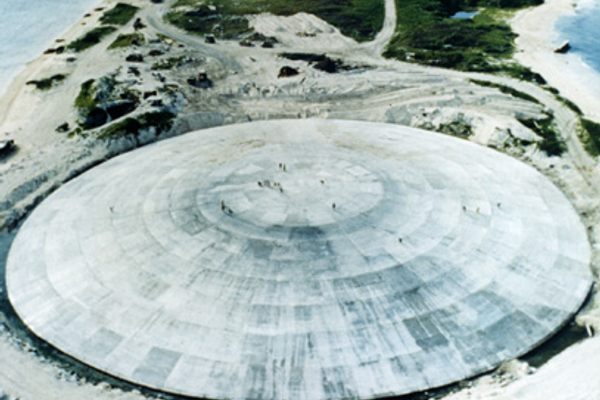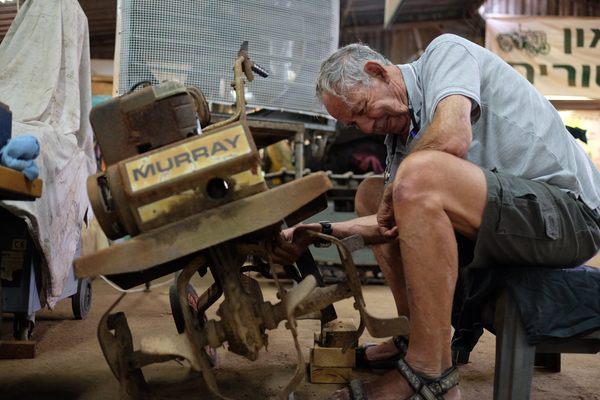In the 1960s, the U.S. Government Set Off a Pair of Nukes Under Mississippi
It’s a nearly forgotten chapter of Cold War history that seems hard to fathom today—even for those who were there.
By all accounts, it felt like the carnival had come to Baxterville that morning.
Kids were out of school on a Thursday. Families were going on picnics. People from the government were handing out Cokes and sandwiches.
“We all got up and got dressed up, and they told us to go to Caney Church,” says Dorothy Breshears, who was 13 at the time. “When we got there, everybody we knew was there.”
But as 10 a.m. drew near, the party-like atmosphere started to grow tense. Which was understandable, considering that an atomic bomb was about to go off about three miles away.
In the decades of the Cold War, the U.S. government conducted more than 1,000 nuclear tests. Most of them were in the Nevada desert or on faraway Pacific islands. But Breshears and her neighbors lived in southern Mississippi, around 100 miles from New Orleans. And on October 22, 1964, the U.S. Atomic Energy Commission was about to blow a gaping cavern in the Earth beneath the pine forests of Lamar County.
It was the first of two nuclear tests conducted there, the only ones on American soil east of the Rockies. It’s a nearly forgotten chapter of Cold War history that seems hard to fathom today—even for some of those who lived through it.
“I never did know why they wanted to do that,” says Donald Nobles, now 80.

Two factors brought the Bomb to Mississippi: suspicion and salt.
By the late 1950s, the United States, the Soviet Union, and Britain were setting off atomic and hydrogen bombs on land, at sea, and in the air. The tests spewed radioactive fallout around the globe, fueling widespread public fears of cancer and birth defects. Pop culture was full of insects and reptiles turned monstrous by radiation. And the countries that did have nuclear weapons wanted to make it harder for others to join the club.
So the nuclear powers started talking about banning bomb tests. And in 1958, experts meeting in Geneva proposed a worldwide network of sensors that would detect nuclear blasts, which appear on seismographs like earthquakes.
But how could you tell if someone was cheating?

In 1959, the American physicist Albert Latter theorized that setting off a bomb in an underground cavity could muffle the blast. After tests with conventional explosives, Latter wrote that a detonation as big as 100 kilotons—more than six times bigger than the bomb dropped on Hiroshima—“would make a seismic signal so weak it would not even be detected by the Geneva system.” His theory, known as “decoupling,” became a rallying point for people who wanted to keep testing, says Jeffrey Lewis, of the James Martin Center for Nonproliferation Studies in Monterey, California.
“They wanted to come up with a reason that we couldn’t verify an agreement with the Soviets,” says Lewis, who’s also the publisher of the Arms Control Wonk blog. But in 1963, after the Cuban Missile Crisis brought the world nose-to-nose with the unthinkable, the superpowers signed the Limited Test Ban Treaty. It kept future tests underground, and researchers turned to making sure those tests would be spotted.
The Atomic Energy Commission wanted to test Latter’s theory using actual nukes. And salt deposits were considered the ideal places for tests, since they could be excavated more easily than rock and the resulting cavity would endure for years. So the search was on for a salt dome in territory similar to where the Russians tested their bombs, Auburn University historian David Allen Burke says.
“It had to be a certain diameter. It had to be a certain size. It needed to be a very large salt dome that was still a distance underground and not where it could interfere with water or petroleum or anything else,” says Burke, who wrote a book about the Mississippi tests.
That led the agency to southern Mississippi, which is full of salt domes. The government leased a nearly 1,500-acre patch of forest atop one of those domes and got to work.

The idea of nuclear testing in an area with several medium to large cities nearby wasn’t universally popular. But Governor Ross Barnett was eager to host the AEC, even as he battled with the Kennedy administration over civil rights.
“Barnett, even though he was a Dixiecrat and a segregationist, and one of the most vociferous, bombastic, and worst, was more than happy to welcome the image of Mississippi as helping to protect the United States from communism,” Burke says.
And Breshears says, when she was growing up, Lamar County was “a small county, very patriotic.”
“If the government told you the moon tomorrow night would be green, everybody would expect a green moon,” she says.

The first blast, code-named Salmon, was a 5.3-kiloton device that would blow a cavity into the salt dome half a mile underground. The second, Sterling, was only 380 tons, and would go off in the cavity left behind by Salmon. AEC crews drilled a 2,700-foot hole down into the salt dome, lowered the first bomb into it, plugged it with 600 feet of concrete… and waited.
The Salmon test was put off nearly a month by a string of technical problems and bad weather, including Hurricane Hilda, which hit one state over in Louisiana. People living up to five miles from the test site were evacuated and recalled twice in preparation for blasts that never happened. They got paid $10 a head for adults and $5 for children for their trouble.
Finally, at 10 a.m. on Oct. 22, came the boom.
Steve Thompson and his family had cleared out of their house for a picnic at Lake Columbia, about 10 miles away. They watched a wave spread across the water—and then through the ground underneath them.
“It was like being in a boat,” says Thompson, who was 15 at the time. “There was two big waves and a bunch of ripples.”
To Brenda Foster, “It felt like the Earth just raised up and set back down.”
“The windows on the house were shaking and rattling, and you could see the chimney on the house cracked all the way down,” says Foster, who was a few days shy of her 10th birthday. “That’s about all I remember of that, but I never will forget it.”

In the aftermath, about 400 people filed claims for damages with the government, mostly for cracked plaster or masonry. On Nobles’s father’s farm, eight miles from the blast site, two wells quit working after the blasts. But one man, Horace Burge, found his house was “completely destroyed,” says Nobles, who was friends with Burge’s son.
“It broke everything on the inside of his house, threw the stuff out of his cabinets, and messed his foundation up,” Nobles says.
More than two years later, in December 1966, the AEC lowered the second bomb into the 110-foot hole gouged out by the first and set it off. The smaller device went almost unnoticed at the surface, and the scientific results weren’t spectacular, either.
Far from Latter’s predictions that a blast as big as 100 kilotons could be kept off the scopes, Lewis says, it turned out that decoupling “is not a worry for anything but a very small explosion.” However, the data helped shape a later treaty which limited underground tests to 150 kilotons.
And the fact that the tests were something of a wash is a good thing, Lewis says. A country that wanted to start building its own nuclear weapons isn’t likely to be able to conceal a test, even if it wanted to—and most aspiring nuclear powers, such as North Korea, are happy to let the world know they have the Bomb.
“Iran has big salt domes,” Lewis says. “The last thing we would want Iran to do is have confidence in how big an explosion they could conduct without being detected. So there are some things we’d rather not know.”

After the tests came a letdown among the locals, Burke says. There were hopes they would help Mississippi’s economy and land a new high-energy particle physics center, but it eventually went to Texas. The AEC was slow to address damage claims, and as the work wound down at the site, “the locals were no longer being involved in things,” he says.
And some people feared the bombs left behind more than a hole in the ground. Everyone seemed to know someone who died of cancer, including Breshears’s uncle, who regularly ate fish he caught nearby.
“Everybody was happy, everybody was laughing and talking and happy,” Breshears says. “Then it was probably five or six years, people started mumbling about ‘What did they do?’”
Most of the radioactive waste produced by the blast was fused into the surrounding salt. But in early 1965, a mix of water and acid poured into the still-hot cavity caused a burst of contaminated steam to spew out of the hole. Drilling into the chamber between and after the tests brought up irradiated chunks of salt, dirt, and drilling fluid, which were dumped back into the cavity or injected deep underground.
In 1989, after residents complained to then-U.S. Senator Trent Lott, the state looked at cancer rates in the area. The results were inconclusive, but the federal government eventually built water lines to nearby homes to replace old wells. Federal records now indicate cancer rates in Lamar County are lower than both the state and national average.

Today, a chest-high granite monument marks the spot where the bombs went off below. It’s tucked away in a clearing down two miles of sandy dirt road, and the buildings and equipment that neighbored it are long gone. The surrounding 1,450 acres are a state timber preserve where conservation officials are trying to bring back the native longleaf pines, quail, and black bears.
The marker is surrounded by test wells for the local groundwater, which gets analyzed regularly for signs of contamination by tritium, a radioactive form of hydrogen. Despite the fears of local residents, the results are well below the maximum safe limit set by the federal government, and often too low to detect. Before the state took over the site in 2010, scientists also took samples from dozens of surrounding trees to test for radioactivity, and found nothing.
The United States and the Soviets halted nuclear testing in the early 1990s, as the Cold War wound down. Only India, Pakistan, and North Korea have lit off nukes since then, and nearly 200 countries have joined a treaty swearing off future tests. (The United States has yet to ratify the pact.)
Burke said the detonations that shook Lamar County not only contributed to arms-control treaties, but helped build a network of scientific instruments that has life-saving applications today, such as estimating tsunami risks after an earthquake.
“This stuff has saved a lot of lives,” he said. “I think that properly understood, that’s something the people around that site have a reason to be proud of.”






















Follow us on Twitter to get the latest on the world's hidden wonders.
Like us on Facebook to get the latest on the world's hidden wonders.
Follow us on Twitter Like us on Facebook